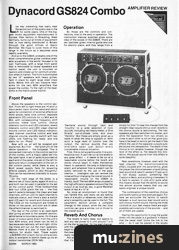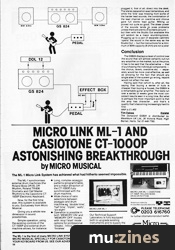Magazine Archive
Home -> Magazines -> Issues -> Articles in this issue -> View
Dynacord GS824 Guitar Combo | |
Article from Electronics & Music Maker, March 1984 | |
A new state-of-the-art guitar amplifier with integral overdrive, chorus and reverb, plus 200W output.

Low key marketing has really kept Dynacord out of the public eye in the UK for some years. One of the biggest music equipment manufacturers in Europe, their factory in Straubing, West Germany, turns out all kinds of equipment that is now being distributed in Britain through the good offices of Gavin Mortimer. We hope to cover more of this range in the future as it becomes more readily available.
And so to the GS824, probably one of the most comprehensive guitar combos available anywhere in the world. Housed in its own flightcase, with a large front panel that is removable to reveal speakers and control panel, the unit is mounted on castors and closes up for optimum protection when in transit. The front is dominated by two 12" speakers with heavy grilles, held in place by eight large steel clips/bolts. Below this are two massive heatsinks for the twin 80W amplifiers that power the combo. To the right of the heatsinks is the mains power switch.
Front Panel
Above the speakers is the control section. From left to right these are: Hi and Lo input-jacks; input volume; send and return jacks for connection of external effects (or more amps); bass tone control; separate parametric EQ controls for Lo Mid and Hi Mid, with corresponding frequency shift controls; treble tone control, chorus intensity control and LED indicator; reverb intensity control and LED; clean channel volume control and LED status indicator; lead channel overdrive control and lead channel volume; standby switch with two LEDs, one flashing for 'ready' and one static for 'on'. Phew!
Bear with us, all will be revealed and explained. But first... the lynch-pin of the whole operation - the footpedal. This is connected internally to the control section of the combo, with a heavy cable led into the open back. A set of jacks is provided at each end of the pedal, one set on the left for send and return (independent of the set on the control panel), while there is also a 9 volt power supply here for powering effects pedals, which is very thoughtful. This can be resoldered internally to supply 15 volts.
On the right edge of the pedal is a second set of input jacks, again Hi and Lo, and both can be used in parallel to the set on the control panel. Three footswitches and four LEDs grace the top - the first switch selects between the clean and lead channels, with an LED for each channel to indicate status, and there's also a switch and LED each for reverb and chorus on/off. The LEDs on the footswitch are linked to those on the panel, and both are lit when the effect/channel is switched in.
The rear of the combo is an open-back slot giving access to the speaker section, while below is mounted a panel. On this are a pair of output jacks direct from the unit's twin 80W amps, and these can be fed to two separate cabinets, left and right. Utilising these will cut out the main speakers. Beside them is a pair of male XLR connectors for studio feed. These supply +6dB/600 ohm unsym, but an extra accessory is available to switch these up via an output transformer (DCN 345).
Operation

So those are the controls and connectors, now to the amp in operation. The instruction manual supplied gives some idea of the scope of the GS824. There are ten 'patches' given, nine for guitar and one for electric piano, and they range from a 'Santana' sound, through 'Jazz' and 'Country' to a wide selection of rock sounds, including two heavy-metal, a 'Dire Straits' out-of-phase tone, and even 'Hendrix'. But these are simply given as a taste of what the amp is capable of. With such a huge level of control over the output, the various sounds that are available span just about every conceivable musical situation.
First, this is not a practice amp. It is a professional tool. It can't be run at low levels to any great effect - it needs to be run at a reasonable volume before the reverb and stereo chorus begin to make themselves heard. In operation, the amp is disarmingly silent, and whatever hiss is present can be subtly removed by the use of the parametrics - intelligent use can remove the noise without changing the overall sound. A 'reasonable' volume on the GS824 is, frankly, loud! The twin 80W amps coupled to the high-efficiency speakers ensure that the output is as loud as, say, a good Marshall stack of two 4 x 12"s!
So, once an environment is found that can handle this, and really we are talking here of a studio or rehearsal room, then the amp's versatility can be used to the full. The parametric section allows a complete change to the output, while the two tone controls can give a similar cut or thrust to the overall sound.
Reverb And Chorus
The reverb is fairly deep, but seems to lack any real power to it until around 7 or 8 on the dial is reached. On the lead channel, with the overdrive on 5 or 6, the reverb does begin to work a little more noticeably, but on the clean channel, a separate echo device is really needed.
Not so the chorus. In fact, this is so good that it's almost worth getting the GS824 simply for this! To hear the change from the straight clean sound (minus even reverb) to the chorus sound is astonishing. The two speakers are then switched into stereo, and while the separation from two drivers so close to each other is not all that good (you have to be dead on axis to get the best of the effect) the use of the separate outputs puts the sound into perspective. The depth of the chorus is not variable however, though the level of the effect is. Yet despite this limitation, the actual sound from this effect is quite beautiful.
Real revelations, however, start with the lead channel. The distortion/overdrive effect, coupled with the parametrics, gives the player the choice between a harsh biting lead sound (á lá Jake E Lee/early Fripp) up to a rich bluesy sustain, something like Clapton or Beck, and anything in between! It is hard to explain in cold print quite what this means, except that the ability to sound like almost anyone means that you can easily engineer a unique sound.
The combination of the overdrive, chorus and reverb opens up new avenues again. For here we encounter the facility to switch between a loud raucous lead sound and a soft chorus rhythm sound. Having the three controls at your feet means there are eight possible permutations of the sounds - and all of them are usable.

Having the opportunity to plug the guitar direct into the pedal is a godsend. It means that the pedal itself forms the link to the amp - so it can be placed in the studio control-room or indeed at the front of the stage, affording a great deal of freedom without the attendant spaghetti of cables that long leads usually entail.
As the GS824 is likely to be recorded from, we took it along to a small studio and plugged it, first of all, direct into the desk. The stereo separation was tremendous, and while the 'bite' was missing from some of the harder lead sounds, the combination of the lead channel on overdrive and chorus gave full stereo lead guitar. Miking up proved not quite so good. The sheer power of the sounds tends to pose problems unless there are plenty of screens around - but then with the Studio Out available this will seldom be a major stumbling-block. Plugging up to a pair of separate cabinets 'opens' the sound in the same way as the Studio Out - but the instructions for a minimum of 80W capacity (8 ohm) are not a joke!
Conclusion
The GS824 displays a level of control over the sound that will almost certainly out-run any amplifier on the market, but at the price, it has to be said that the alternative - that of purchasing the individual components - the chorus, reverb, overdrive etc. - separately would be more cost-effective, as well as allowing for the fact that should any single area of the system go wrong, repairs would not affect the rest.
Having said that (which is, after all, like saying that buying a series of huts is cheaper than buying a house), the GS824 is a remarkable guitar amplifier. The tests run over a series of weeks gave the most consistent results seen in a long time. But what is perhaps the most important point is that the amp has character... and that's a quality that's becoming increasingly hard to find.
RRP is £1,450
(Contact Details)
Publisher: Electronics & Music Maker - Music Maker Publications (UK), Future Publishing.
The current copyright owner/s of this content may differ from the originally published copyright notice.
More details on copyright ownership...
Review by Tim Oakes
Previous article in this issue:
Next article in this issue:
Help Support The Things You Love
mu:zines is the result of thousands of hours of effort, and will require many thousands more going forward to reach our goals of getting all this content online.
If you value this resource, you can support this project - it really helps!
Donations for October 2025
Issues donated this month: 0
New issues that have been donated or scanned for us this month.
Funds donated this month: £0.00
All donations and support are gratefully appreciated - thank you.
Magazines Needed - Can You Help?
Do you have any of these magazine issues?
If so, and you can donate, lend or scan them to help complete our archive, please get in touch via the Contribute page - thanks!




